Every now and then, a device comes along and challenges you to consider the viability of an entirely new product category. That’s precisely what Lenovo is doing with the Yoga Book 9i. By replacing the traditional physical keyboard with a second display, the company is rethinking what a laptop can do. In tight confines, you can rely on a virtual keyboard or an included magnetic alternative. But when space isn’t a concern, you can prop the whole system up on its custom folding cover to create an engaging dual-screen workspace. It’s like a miniature all-in-one PC that’s incredibly easy to carry around. And while its software still needs work and it costs twice as much as a standard clamshell, the Yoga Book 9i is proof that it’s worth exploring this new branch of the laptop’s evolutionary tree.
Design and displays
There’s a profound elegance to the Yoga Book 9i’s design. Though the laptop’s bottom half is a bit thicker than the top, it feels like Lenovo has boiled the device down to its most basic components: two halves (in this case, screens) joined by a hinge in the middle. The dual 13.3-inch displays (2,880 x 1,800) look great too, boasting OLED panels with rich colors and a tested brightness just shy of 400 nits.
Lenovo
Lenovo Lenovo Yoga Book 9i
Pros
- Novel design
- Lots of bundled accessories
- Better-than-expected battery life
- Functions as a portable all-in-one PC
Cons
- Expensive
- Poor dual-screen support in Windows
- Lots of bloatware
- Typing on a touchscreen can be awkward
- No 3.5mm audio jack
Around the outside, the Yoga Book features a polished metal frame with three Thunderbolt 4 ports, which is nice to see on a system this size. Unfortunately for fans of wired audio, you don’t get a 3.5mm audio jack. Thankfully, Lenovo’s 5-megapixel IR webcam is sharper than what you get on most competing devices, and holding everything together is the company’s signature speaker bar hinge, which is impressively loud and punchy. All told, despite being slightly heavier than a typical 13-inch ultraportable due to that second layer of glass, it’s still very easy to carry around.
The remaining pieces of the Yoga Book 9i’s kit are its accessories, which include a stylus, a detached magnetic physical keyboard, a folding kickstand cover and even a sleek travel mouse. The keyboard communicates via Bluetooth and has its own USB-C port for charging. Despite its size, it doesn’t feel cramped and offers more key travel than you might expect. During transport, the cover wraps around the keyboard to keep it protected, while Lenovo’s Digital Pen 3 can be stashed in the attached loop.
The mouse is the odd one out because while it’s a handy inclusion, it’s also rather basic (its only noteworthy characteristic is having a toggle on the bottom for quickly switching between two paired devices). Plus, it doesn’t attach to the rest of the system in any way. However, what you can create when you put these pieces together is when things get really interesting.
A dual-mode machine
In clamshell mode, the Yoga Book 9i looks and functions like a regular laptop. But of course, it’s missing a discrete keyboard and touchpad, so what do you do when you need them? That’s easy, you just tap eight fingers on the bottom panel and instantly you get virtual stand-ins. And for times when you only need to mouse around, you can use a three-finger tap instead, which summons a floating touchpad that leaves room for Lenovo’s widgets (weather, news, etc.) or anything else you’d like to put down there.
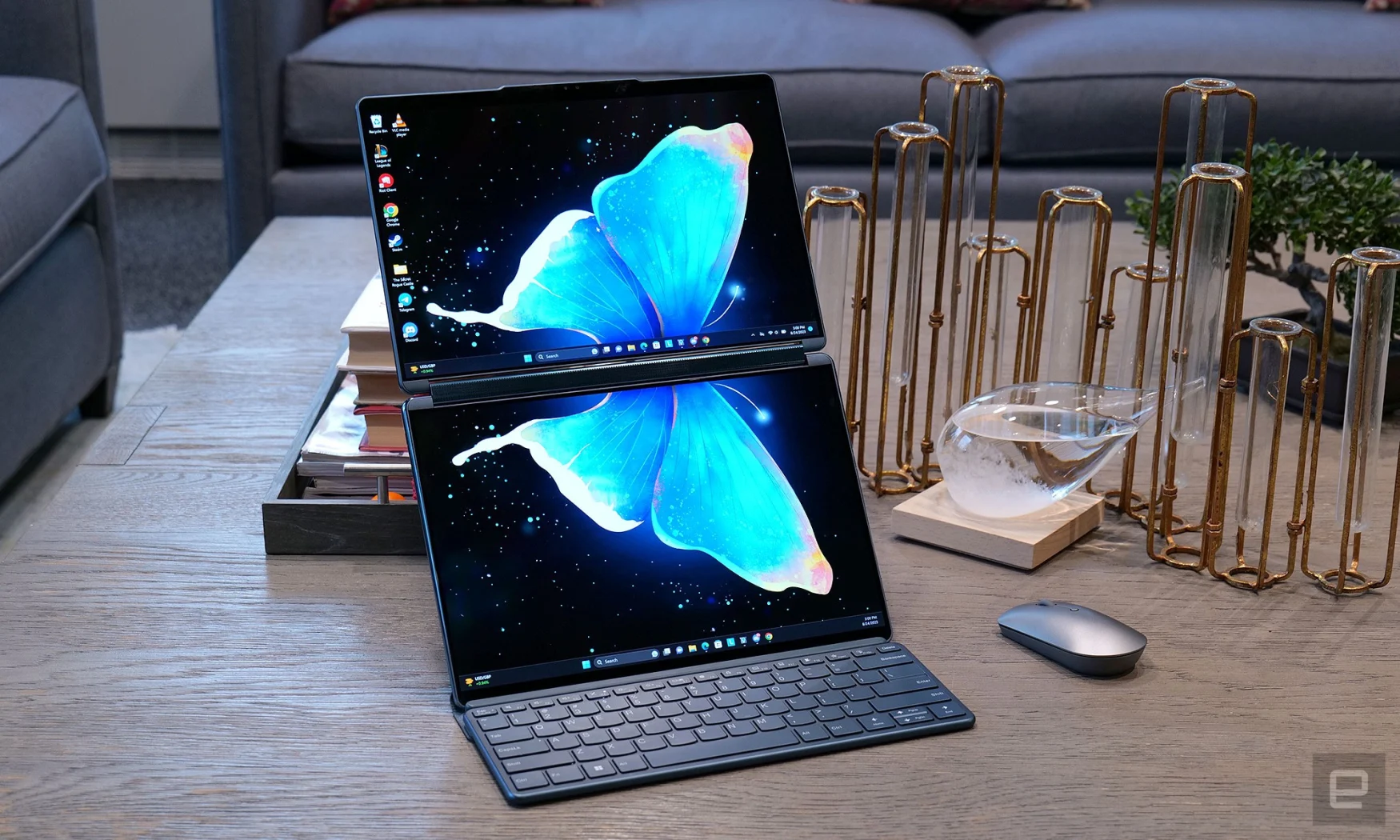
Photo by Sam Rutherford/Engadget
Surprisingly, typing on a touchscreen isn’t as bad as you might think. Don’t get me wrong, it’s still not nearly as fast or accurate as using a physical keyboard. But it’s serviceable, as long as you’re willing to make some adjustments. You can’t slam your fingers down because there are no switches or actual keys with depth to cushion every strike and you need to be more aware of when your hands start to drift lest your sentence devolves into a jumble. But after a little practice, I’m able to hit 60 to 65 words per minute, which is down from around 85 wpm normally. As for mousing, the tackiness of the glass means swiping around isn’t quite as fluid either. But that’s OK, because if you don’t want to rely entirely on a virtual keyboard or touchpad, you don’t have to.
Dropping Lenovo’s keyboard on the bottom screen instantly converts the Yoga Book into a more traditional setup. The magnets inside even help align it properly. From there you can type away on physical keys if you prefer. Just don’t forget to remove the accessory before you close the lid.
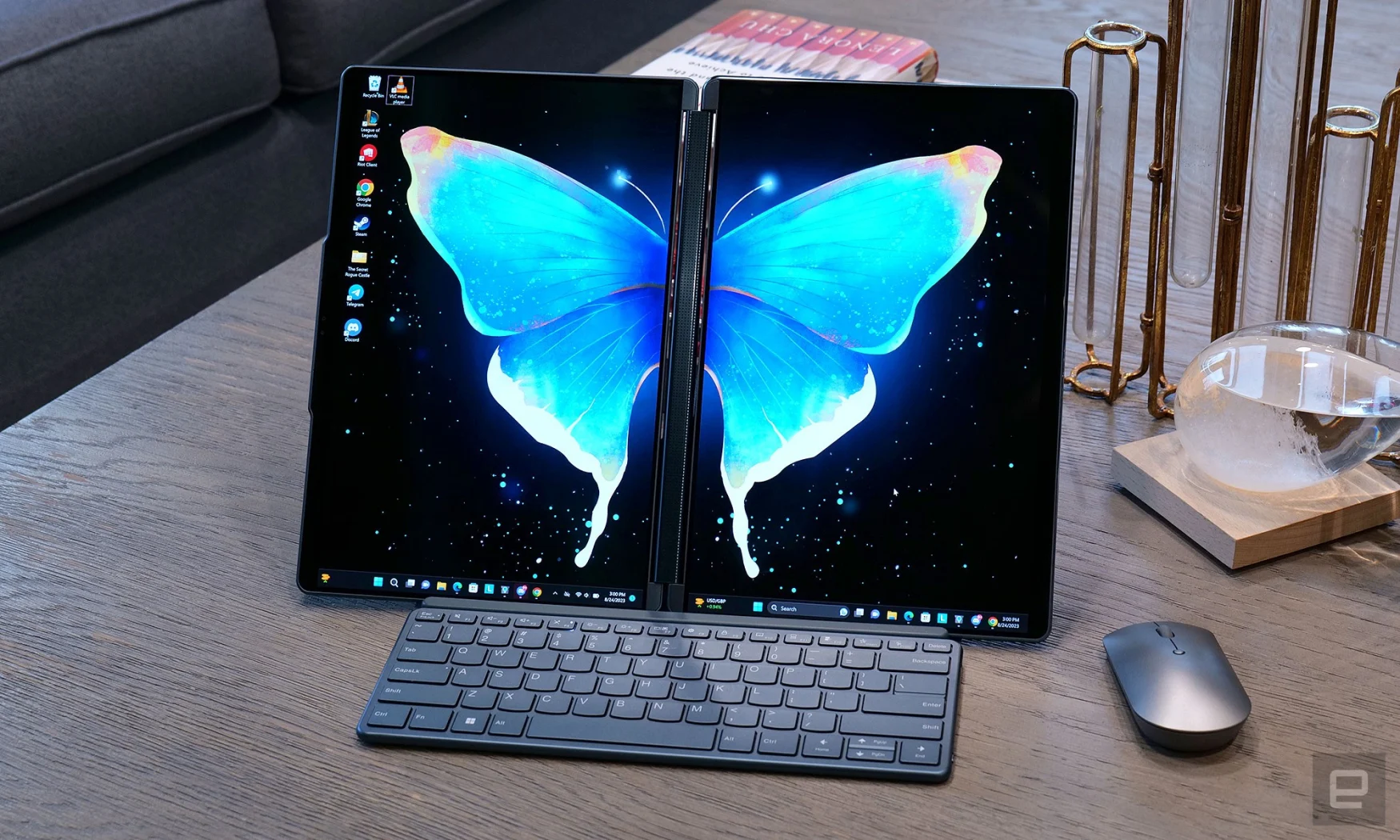
Photo by Sam Rutherford/Engadget
What’s most impressive about the Yoga Book 9i’s is its ability to transform into a portable all-in-one PC when it’s propped up on its kickstand cover. In this mode, there are two options for its displays: a stacked setup with one screen on top of the other and a side-by-side arrangement. Both configurations have their uses. Dual portrait-mode panels are great for quickly referencing materials like spec sheets while writing. Alternatively, the vertically stacked orientation is excellent for keeping an important project open up top while the bottom screen is reserved for email or messaging apps.
Regardless of your preference, simply having the ability to use two displays on a device gives the Yoga Book 9i a unique advantage over pretty much every normal laptop. Sure, you can recreate a similar situation using a bunch of add-ons, but it’s never going to be quite as sleek.
Software
The biggest downside to the Yoga Book 9i is that while its hardware is solid, its software is hit or miss. Lenovo attempts to mitigate this with its User Center, which does a great job of showcasing the laptop’s dual-screen features and is an easy place to adjust settings like display modes, brightness and more.
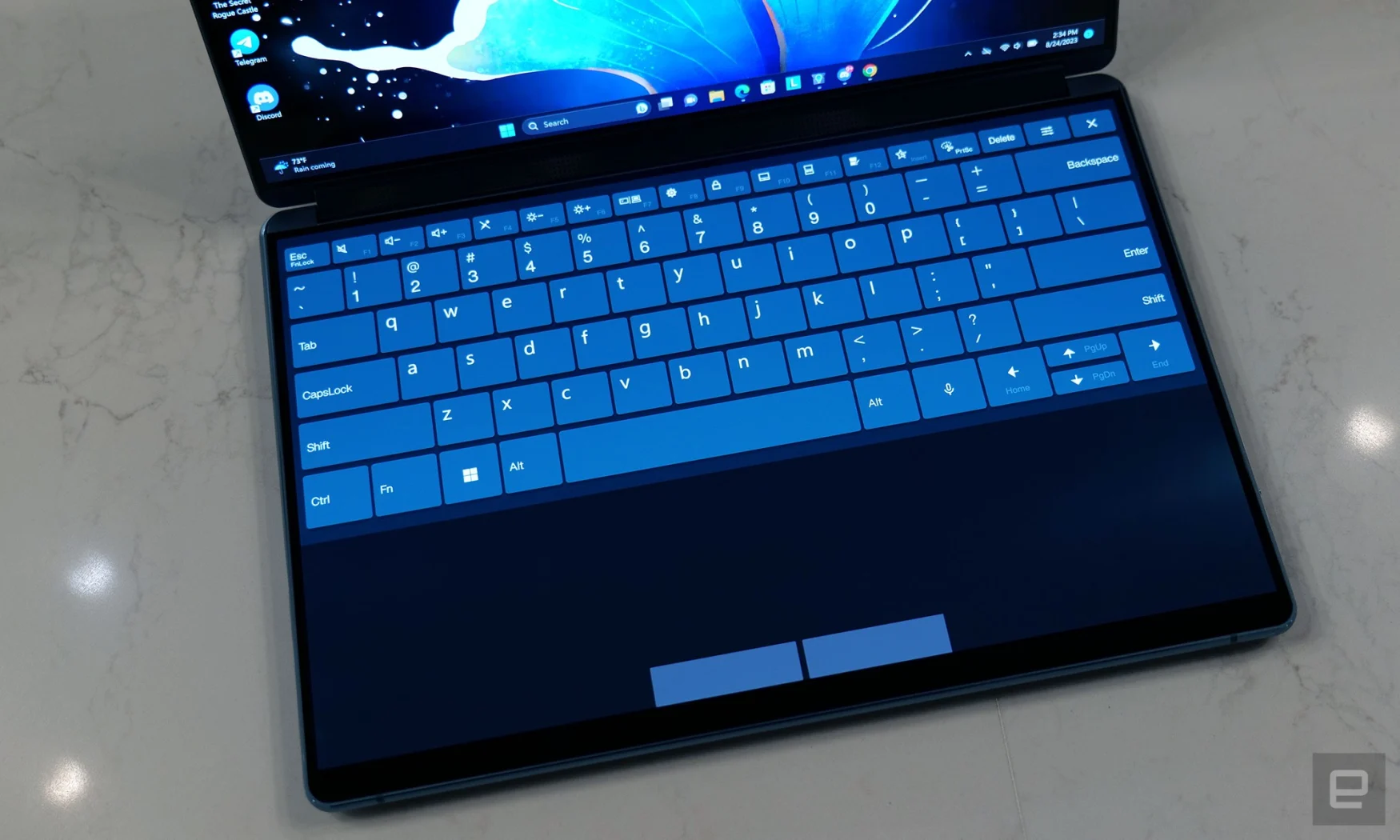
Photo by Sam Rutherford/Engadget
Unfortunately, even with the extra assistance, it’s clear Windows 11 isn’t designed for laptops like this. Sometimes when launching full-screen apps like a game, the Yoga Book gets confused and puts the window on the wrong panel. Other times, like when you’re installing a program or logging in, a prompt pops up that completely disables the lower display, which is kind of annoying when you’re relying on a virtual keyboard and touchpad. I can understand that it’s hard to optimize software when you don’t have a device to test things on. But even so, there’s no hiding that this creates a stilted experience compared to a standard laptop, and if you’re considering buying a Yoga Book 9i, this is a truth you’re going to have to live with (at least for now).
Performance
Packing an Intel Core i7-155U chip, 16GB of RAM and 512GB of storage, the Yoga Book 9i can handle most productivity needs. Even when multitasking across both displays, performance felt relatively snappy. However, if you’re planning on regularly doing more demanding things like video editing, you’ll probably want a beefier machine. On our video encoding test, the laptop took a minute and a half to convert a one-minute movie trailer from 4K to 1080p. That’s not great when compared to systems with faster chips that can perform the same task in 30 to 40 seconds.
Battery life
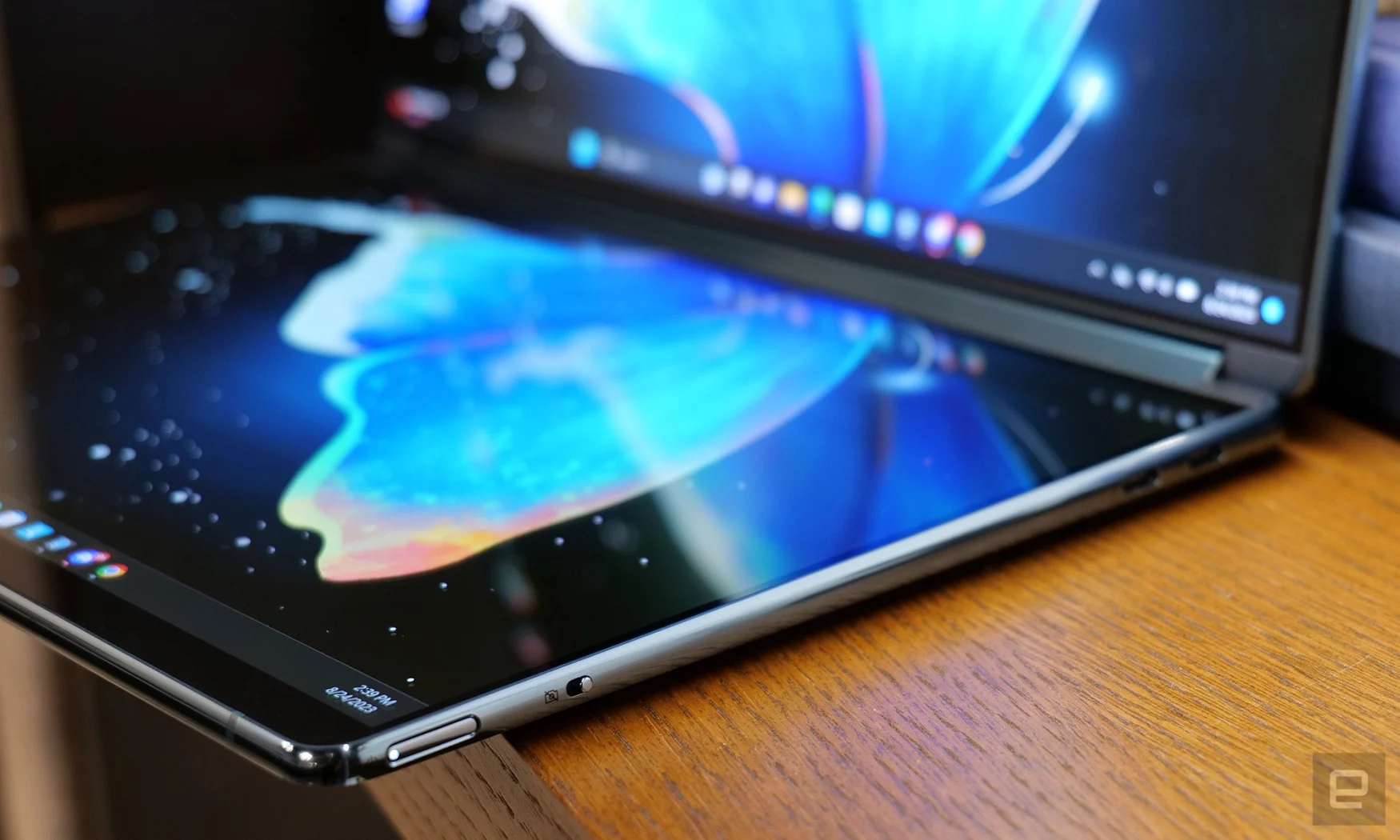
Photo by Sam Rutherford/Engadget
Even with a relatively large 80Wh battery, for a system with two screens, the Yoga Book 9i fared better than expected on our standard video rundown test. It posted a time of eight hours and 12 minutes, which is a couple hours shorter than traditional similarly-sized rivals like the Asus ZenBook S 13 (10:39). But it’s longer than what you get from more powerful thin-and-light gaming notebooks, which often struggle to get north of five hours on a charge.
Wrap up
As the first laptop to feature two displays, the Yoga Book 9i is a rather divisive machine. Starting at $2,000, not only is it really expensive, its performance is also slower than more traditional competitors in this price range. However, for people like me who constantly yearn for more screen real estate when I’m away from home, Lenovo has created something that is more than the sum of its parts. When space is limited, the Yoga Book 9i’s clamshell mode feels right at home on an airplane tray table. But when it’s not, it can expand into a portable dual-screen workstation–complete with all the fixings of your desktop at home. And when you need to pack up, everything collapses into a neat, semi-self-contained bundle that fits in the smallest of laptop bags.
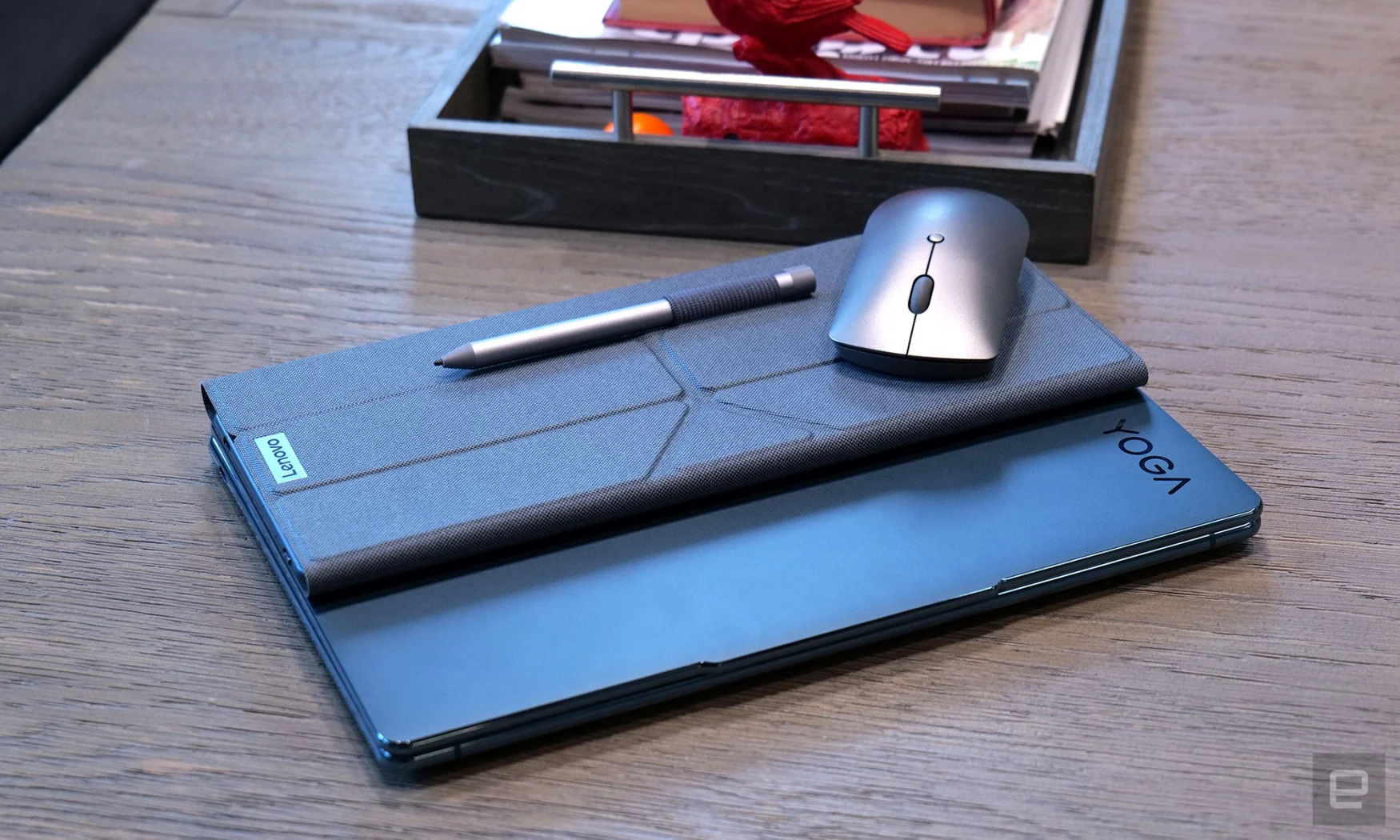
Photo by Sam Rutherford/Engadget
The Yoga Book 9i is a nifty little transformer that’s more engaging than anything Michael Bay has directed in the last two decades. With how little laptops have changed recently, it feels like the Yoga Book has even more room to grow in the years to come. Sure, it’s still a bit awkward, but as the starting point for a new type of notebook, Lenovo’s debut dual-screen convertible has me convinced.
Credit: Source link


Comments are closed.